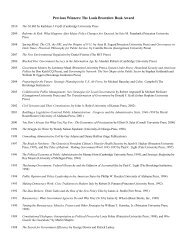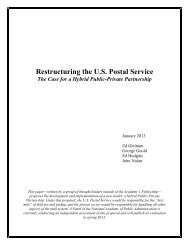High-Performance Partnerships - National Academy of Public ...
High-Performance Partnerships - National Academy of Public ...
High-Performance Partnerships - National Academy of Public ...
Create successful ePaper yourself
Turn your PDF publications into a flip-book with our unique Google optimized e-Paper software.
STAGES OF A PARTNERSHIP:<br />
WHAT DIFFERENCE DOES MATURITY MAKE?<br />
chapter ten<br />
short or interim success. For example, it can<br />
measure customer satisfaction and use interim<br />
data on changes in community conditions for<br />
the partnership’s duration. However, most<br />
serious public policy issues cannot be resolved<br />
in a few years. Even if early trends are positive,<br />
there is no guarantee that fundamental causes<br />
have been addressed. During its midlife, a<br />
partnership may be better positioned to produce<br />
interim indications <strong>of</strong> sustainable results.<br />
A partnership can truly evaluate its effectiveness<br />
once it has grown to scale. At that point,<br />
it serves an entire target population, and<br />
assesses its fundamental improvements for<br />
clients and the community. The bar for<br />
achieving results continually gets higher as the<br />
partnership matures, so the challenge is to live<br />
up to these increasing expectations. At scale, a<br />
high-performance partnership leverages its<br />
impact to achieve results beyond its immediate<br />
control. Many variables can influence outcomes.<br />
A partnership accepts responsibility<br />
for changing community conditions.<br />
As the partnership matures, it must stay current.<br />
Strategies used to deliver services during<br />
start-up may not be as successful down the<br />
line. Continuous improvement and innovation<br />
are hallmarks <strong>of</strong> a successful partnership.<br />
Keeping the partnership energized and innovative<br />
to produce outstanding results is an ongoing<br />
challenge, too.<br />
LEADERSHIP<br />
One or two individuals generally take the lead<br />
when a partnership is created. These strong,<br />
visible champions must be directive in their<br />
style to pull the organization and mission<br />
together. They also must inspire others to join<br />
the partnership and get them moving in the<br />
same direction.<br />
Following the start-up phase, the convening<br />
champions still may be active, yet move toward<br />
the sideline. Facilitators and managers emerge<br />
as key leaders because the partnership must<br />
focus on institutionalizing its operations, honing<br />
its systems, and producing results. Joint<br />
ownership <strong>of</strong> the mission and values is critical,<br />
as leadership must create shared responsibility<br />
for activities and outcomes. Leadership equals<br />
empowerment <strong>of</strong> the entire organization.<br />
When a partnership enters its mature phase, leadership<br />
is diffused throughout the organization.<br />
Leadership cannot be personality driven over the<br />
long haul. The next generation must move forward,<br />
focusing on continual improvement.<br />
The challenge is to keep the partnership from<br />
going on “cruise control” when moving into the<br />
mature phase and at-scale operations.<br />
Maintenance mode is not acceptable for a highperformance<br />
partnership. An organization can<br />
become obsolete if it does not continuously<br />
improve its operations. The need for “drivers” is<br />
the one constant about the leadership challenge.<br />
No matter how mature or successful a partnership,<br />
someone—hopefully more than one—<br />
must strive for excellent performance.<br />
MISSION/STRATEGIC<br />
PLANNING<br />
Maturing has a limited impact on a partnership’s<br />
mission and strategic planning requirements.<br />
At every phase <strong>of</strong> development, the<br />
organization must have a clear compelling<br />
mission and strategic work plans for accomplishing<br />
it. Mission statements should change<br />
little over time. Strategic plans, on the other<br />
hand, should be routinely updated to reflect<br />
work plan requirements.<br />
Gaining consensus on the mission—and clearly<br />
communicating it to everyone—is the real<br />
challenge. Aligning the mission with the<br />
members must occur early in this process. The<br />
second challenge is developing the strategic<br />
plan early enough so that there is a collective<br />
work effort for the most important activities.<br />
Throughout the partnership’s development, it<br />
is imperative that the plan be revisited and<br />
updated as appropriate.<br />
RESOURCES<br />
A start-up partnership <strong>of</strong>ten scrambles to<br />
obtain sufficient resources for basic operations.<br />
Searching for a diversified and secure revenue<br />
base is integral to most activities. Yet it is more<br />
intense following the initial start up.<br />
As a partnership becomes operationalized, its<br />
members begin to redirect their resources and<br />
align them with activities. Further, the partnership<br />
has participated in several budget<br />
cycles, and has begun to establish its perform-<br />
120 Powering the Future: <strong>High</strong>-<strong>Performance</strong> <strong>Partnerships</strong>









